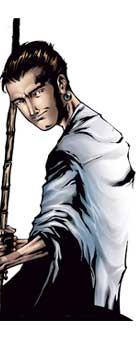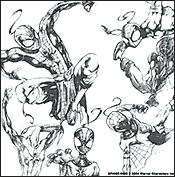Home > News > Specials
The Rediff Special/M D Riti
September 16, 2004



Can you imagine Spiderman clad in white dhoti, red kurta, cummerbund, and red jootis? Battling a rakshasa instead of the Green Goblin? Or spinning his web across the Taj Mahal or the Gateway of India?
From next month, Indian readers can follow the adventures of our own desi version of Spiderman, published by an Indian company, Gotham Comics, on licence from Spiderman's American publisher.
Spiderman, in this new avatar, has been designed by Jeevan Kang, head of Gotham's studio in the heart of Bangalore.
Kang, an architect by training, has been working on various comic characters for Gotham for some years now, but this is the first one that will actually hit the stands. Kang himself has done all the pencilling and inking of the storyboards for the Indian Spiderman.
"I am living my dream now," an excited Kang told rediff.com at the Gotham studio. "This is the first time an Indian artist has worked on a major American comic character. It was fun reinventing Spiderman." Marvel Comics, the American publisher, has already declared his artwork to be of international calibre.
Just how did he set about doing this?
"I had to keep the integrity of the character of Spiderman intact," said Kang. "Also, his easily identifiable characteristics. Then, I had to weave Indian symbols into all this."
Interestingly, Kang said, he never felt afraid when he was attempting this, even though Spiderman is, as Kang himself puts it, "a global icon with a huge history".
 But why Spiderman? Why not Batman, Superman, or an original Indian creation?
But why Spiderman? Why not Batman, Superman, or an original Indian creation?
"Because Spiderman is someone everyone can relate to," Kang explained. "Peter Parker is an underdog, and all of us have been through that phase at some point, mostly when we were teenagers."
Pavitr Prabhakar, as Peter Parker's Indian alter ego is called, is a college boy. The original Parker was a high school student in the US, which means he was the same age as a boy starting college in India.
Gotham's target reader is not just the teenager, but people of all ages. "Spiderman has a simple moral, always," said Sharad Devarajan, the Indian American who launched Gotham. "With great power comes great responsibility. And that is something everyone can relate to."
Prabhakar is Kang's personal creation. He began work on it about six months ago. His storylines and characters have been tested extensively in India on focus groups, and the results, according to Devarajan, have been very positive.
Only the bottom half of Spiderman has been changed. His mask and torso look just the same. But instead of red tights, he now wears a white dhoti and white cummerbund. His red boots have been replaced by red jootis, as this traditional Indian footwear is now quite popular even internationally.
"I tried changing the top half," Kang admitted, "but Spiderman without that typical red face mask and red top simply didn't look like Spiderman."
As for the storyline, Gotham isn't saying much right now. All that they will reveal is that Prabhakar is a village boy who has come to Mumbai for his college education. He feels like an outcast in the big city, because his values, his ways, and his culture are so different. His only friend is the fashionable, urbane college girl Meera Jain (the Indian version of Mary Jane Parker).
"We have focused on the very relevant contemporary Indian theme of rural-urban migration, and the adjustment problems it brings," Devarajan said.
But is not a real Indian village boy who migrates to Mumbai, to go to college there, likely to wear jeans rather than dhotis? "When India has such wonderful clothing traditions," argued Devarajan, "why not use them?"
 But why Indianise Spiderman now? "We were looking for innovative ways to push our brands," Devarajan told rediff.com from Gotham's studio in the heart of Bangalore. "At first, we thought we would make Spidey have an adventure in India. Then we went a step further and thought, when he takes off his mask, he should have an Indian face. Why not make this international hero an Indian boy?"
But why Indianise Spiderman now? "We were looking for innovative ways to push our brands," Devarajan told rediff.com from Gotham's studio in the heart of Bangalore. "At first, we thought we would make Spidey have an adventure in India. Then we went a step further and thought, when he takes off his mask, he should have an Indian face. Why not make this international hero an Indian boy?"
Besides, Kang and Devarajan have loved this comic-strip character ever since they were children. "I have always loved comics," said the tall, well-groomed entrepreneur, who looks like a posterboy for his own superhero comics. "Probably the first words out of my mouth as a kid were Spiderman and Batman. I've been a comic book fan all my life."
First-generation Indian American Devarajan started Gotham Entertainment in 1997 with a partner, Suresh Seetharaman, who was creative director at the J Walter Thompson ad agency.
The process really began when Devarajan, a graduate in fine arts, did his internship at DC Comics in New York in 1996. While there, he asked the company whether he could market their comics in South Asia. DC Comics has a large repertoire of popular characters like Superman, Batman, Wonder Woman, AquaMan, the Flash, and Green Lantern.
DC agreed, and Gotham was born. A year later, they signed up EC Publications, a unit of DC Comics, to distribute MAD magazine. The company now also has licensing agreements with Marvel Comics, Dark Horse Comics, and Warner Brothers Worldwide Publishing.
Gotham has over 1.5 million readers of 13 monthly magazines and children's books, distributed and printed in English, as also in Hindi, Bengali, Tamil, and Malayalam. Advertisements from top multinational firms such as Pepsi, Johnson & Johnson, Nestle, and Frito Lay, as well India's Top Ramen Noodles, Uncle Chips, and Britannia in the issues bring in more revenue.
"I knew it would work, because I had seen, on my trips to India, that there was an incredible knowledge of popular comic book characters even in the remotest villages, but no actual comic books that kids could read," Devarajan said. "We thought we would begin by bringing international comics to India, and then create our own indigenous superheroes sourced from Indian mythology. Ultimately, we want to create apex characters that have a global appeal from our own rich history, culture and heritage."
There are many such newly designed comic book heroes who are now on Gotham's drawing boards, but Spidey will hit the stands first, in India next month and in the US at the end of the year, published by Marvel Enterprises. As of now, there will be a series of four comics featuring Pavitr Prabhakar released on the market every week, for a month. After that, Gotham will decide whether to continue the series, depending on how well these issues do.
Gotham is unwilling to reveal the pricing of the comics yet, whether it will be the same as for the American strip. Devarajan also hinted at the possibility of a collector's edition, published on glossy paper at higher cost, right at the beginning. Printing will not be a problem as Gotham has a network of presses all over South Asia where they get their comics printed now.
Prabhakar is, of course, aimed primarily at the Indian market, although the comics will be sold at Gotham's regular outlets all over South Asia. After the launch of the English edition, it will also be printed and sold in Hindi, Tamil, Bengali and Malayalam.
Gotham now has 15 artists working for them in Bangalore. They hope to increase this number to 50 by the end of the year, if their plan to introduce comics with original Indian superheroes goes as per schedule. "We want to revolutionise Indian pop art and create a unique style of Indian comic art," said Devarajan. "It's time India became known globally not just for its quantitative abilities but also for its creative abilities."
Headline Image: Uday Kuckian